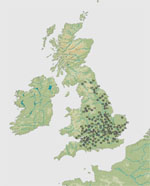
The incorporation of Britain into the Roman empire led, as in other provinces, to the development of a network of settlements which did not have the same status or appearance as a city (civitas capital). Some were urban or semi-urban, with a sizeable population, well-developed industrial or commercial activity and other special functions. Others were more obviously agricultural in character, farming communities or rural villages of varying size.
The range of size of such settlements is immense. Water Newton (Cambs) had a defended area of 18ha, with activity outside the walls covering an area seven times as large. This is larger than the smallest of the civitas capitals, so there is some overlap in the sizes of these types. But most small towns were much smaller than the civitas capitals or coloniae, typically covering an area of 10ha or less. In many cases the full extent of settlement is not known. At the lower end of the scale there is no sharp distinction between what we call ‘small towns’ and the larger, prosperous agricultural villages.
The Latin term vicus was probably used for all such settlements above the level of the smallest rural hamlets. In Britain the evidence for the status and character of these settlements – usually known as ‘small towns’ in English – is entirely archaeological. Vici in this sense – small towns and villages that grew with the development of the Roman provincial economy – are to be distinguished from the settlements of civilians attached to Roman forts in the permanently garrisoned frontier zones of Britain, in northern England and Wales. These settlements were primarily dependent on the pay of the military unit they served, and it is unclear how much economic interaction they enjoyed – if any at all – with the inhabitants of their surrounding countryside. The Romans called these settlements vici as well; but here they will be termed ‘military vici’, to distinguish them from the small towns that became characteristic of the lowland areas of Britain.
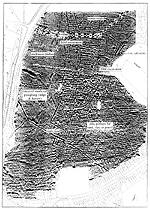 Our picture of the ‘small towns’ is far from complete. New examples are
being discovered all then time: not always easy to recognise, ‘small towns’
are a relatively recent addition to the repertoire of site-types in Roman Britain.
For example, there was little to indicate the existence of the large town at
Brampton (Norfolk) before the 1960s; new ‘small towns’ at Shepton Mallett (Somerset)
and Elms Farm, Heybridge (Essex) were only revealed in the 1990s. While these
and several new examples have been discovered in recent decades by means of
aerial photography and development driven rescue archaeology, very few, even
of those long known, have ever undergone large-scale excavation. Enough is
known of the distribution of the smaller towns, however, for us to see clearly
that this mirrors that of the villas. Although this distribution is largely
confined to the south-eastern, lowland, part of Britain. There are exceptions:
there is a well-known small town at Cowbridge (Glamorgan), in southern Wales, with a number of villas in its vicinity. Very recent discoveries in
the Tees Valley area of northern Britain, only 40km south of Hadrian’s Wall,
have revealed for the first time formerly unsuspected villa sites and, at Hardwick
Park, Sedgefield (Durham), an extensive site with the characteristics of a ‘small town’ which
was flourishing during the second century.
Our picture of the ‘small towns’ is far from complete. New examples are
being discovered all then time: not always easy to recognise, ‘small towns’
are a relatively recent addition to the repertoire of site-types in Roman Britain.
For example, there was little to indicate the existence of the large town at
Brampton (Norfolk) before the 1960s; new ‘small towns’ at Shepton Mallett (Somerset)
and Elms Farm, Heybridge (Essex) were only revealed in the 1990s. While these
and several new examples have been discovered in recent decades by means of
aerial photography and development driven rescue archaeology, very few, even
of those long known, have ever undergone large-scale excavation. Enough is
known of the distribution of the smaller towns, however, for us to see clearly
that this mirrors that of the villas. Although this distribution is largely
confined to the south-eastern, lowland, part of Britain. There are exceptions:
there is a well-known small town at Cowbridge (Glamorgan), in southern Wales, with a number of villas in its vicinity. Very recent discoveries in
the Tees Valley area of northern Britain, only 40km south of Hadrian’s Wall,
have revealed for the first time formerly unsuspected villa sites and, at Hardwick
Park, Sedgefield (Durham), an extensive site with the characteristics of a ‘small town’ which
was flourishing during the second century.
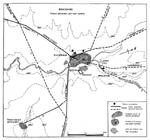
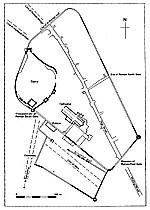 At least a third of known small towns are known to have developed from
a pre-conquest Iron Age site. This pattern of development is particularly noticeable
in those parts of south-east Britain where there was major contact with the
Roman world before AD 43. Good examples of this are Braughing (Herts), where a focus of several Iron Age trackways became a nodal point of
Roman roads, and Rochester (Kent), where coins were minted in the pre-Roman Iron Age. Many of these developments
from Iron Age antecedents involved religious continuity, because of the presence
of a shrine or sanctuary, as we shall see at Bath (Avon), Harlow (Essex) and
Springhead (Kent). This focussing of a Roman-period small town on a pre-Roman
shrine is also evident at the recently discovered site at Elms Farm, Heybridge
(Essex).
At least a third of known small towns are known to have developed from
a pre-conquest Iron Age site. This pattern of development is particularly noticeable
in those parts of south-east Britain where there was major contact with the
Roman world before AD 43. Good examples of this are Braughing (Herts), where a focus of several Iron Age trackways became a nodal point of
Roman roads, and Rochester (Kent), where coins were minted in the pre-Roman Iron Age. Many of these developments
from Iron Age antecedents involved religious continuity, because of the presence
of a shrine or sanctuary, as we shall see at Bath (Avon), Harlow (Essex) and
Springhead (Kent). This focussing of a Roman-period small town on a pre-Roman
shrine is also evident at the recently discovered site at Elms Farm, Heybridge
(Essex).
Further north and west, especially in the areas beyond the Fosse Way, there are fewer small towns with obvious pre-Roman Iron Age antecedents, and more cases can be seen where small towns have developed out of the network of Roman forts and roads employed during the conquest. Even here, there is a category of small town sites characterised by an irregular and haphazard network of streets or lanes that do not relate to any major through route or ribbon development, as for example at Irchester (Northants). These plans resemble somewhat agricultural ‘villages’ such as Chisenbury Warren (Wilts) and Hacconby Fen (Lincs); this organic kind of plan may indicate a native tradition of village or property layout surviving into the Roman period. Irchester, and other examples of this, such as Ashton (Northants), Dragonby and Kirmington (Humberside, have known pre-Roman Iron Age antecedents.
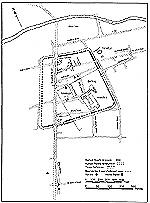 It was once believed that the majority of small towns came into being
when forts were abandoned as the army advanced further north and west following
the conquest of 43. By around 75 the army had moved on into Wales and the Pennines.
It was thought until recently that the settlements of camp-followers and traders
that had grown up outside the forts of lowland Britain had become sufficiently
important economic centres between 43 and about 75 for them to be able to survive
the departure of the garrison that had originally attracted them. However,
in the south-eastern part of Britain, already in contact with Rome before the
conquest, very few forts are actually known on the sites of later small-towns.
Here reassessment has also shown that claimed forts (for example Chelmsford,
Essex), may not have existed. Here we have far more Iron Age centres than
Roman military vici to explain the origins of small towns.
It was once believed that the majority of small towns came into being
when forts were abandoned as the army advanced further north and west following
the conquest of 43. By around 75 the army had moved on into Wales and the Pennines.
It was thought until recently that the settlements of camp-followers and traders
that had grown up outside the forts of lowland Britain had become sufficiently
important economic centres between 43 and about 75 for them to be able to survive
the departure of the garrison that had originally attracted them. However,
in the south-eastern part of Britain, already in contact with Rome before the
conquest, very few forts are actually known on the sites of later small-towns.
Here reassessment has also shown that claimed forts (for example Chelmsford,
Essex), may not have existed. Here we have far more Iron Age centres than
Roman military vici to explain the origins of small towns.
Further north and west there is a much clearer correlation between the sites of forts and of later small towns. Godmanchester (Cambs) and Great Casterton (Leicester), both on Ermine Street, Northwich (Cheshire), and Wall (Staffs), on Watling Street, have all been seen as small towns developing from fort vici. Although there were undoubtedly forts at all these places, a simple growth from vicus into small town is probably not what happened in the majority of cases. Firstly, it is now believed that rather than being peopled by native traders from the surrounding area, fort vici were built for camp-followers who arrived with the army, and who are likely to have moved on with the unit when it advanced to a new base. It is worth noting that the agricultural nature of the earliest post-fort development at Godmanchester is not characteristic of what we are accustomed to see in military vici, where craft and trade seem to predominate.
Even without a direct continuity between the military vici and the new small towns, the presence of a prominent abandoned military site, usually at a centre of routes, was probably decisive in providing an obvious centre where native communities might establish a market linked to the provincial communications network. In many cases an official role may have survived the departure of the military, for example for posting stations on the cursus publicus. It is not impossible, although we have no evidence, that there was sometimes official encouragement or direction of ‘small town’ development at sites abandoned by the military. At one small town where a military origin is particularly clear, Alchester (Oxon), now known to be site of a legionary base of the period before AD 50, the situation at a main road intersection may have been as critical as any civil settlement attached to the fortress. At a site like this it is also worth considering whether veteran settlement – or some other form of state policy – may have played a greater role in the origins of the small town than is usually thought.
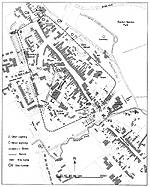 Obviously there are a number of small towns and villages where we have
no evidence for either a pre-Roman Iron Age or a Roman military origin. There
must be at least some among these where a Roman fort or an Iron Age site awaits
discovery, but others must have sprung from nowhere as the road network and
economy of the Roman province developed. Unsurprisingly, many of these new
foundations developed on roads and at other important nodes of communication
in the developing province, for example at Towcester (Northants) or Cave’s Inn (Warks).
Obviously there are a number of small towns and villages where we have
no evidence for either a pre-Roman Iron Age or a Roman military origin. There
must be at least some among these where a Roman fort or an Iron Age site awaits
discovery, but others must have sprung from nowhere as the road network and
economy of the Roman province developed. Unsurprisingly, many of these new
foundations developed on roads and at other important nodes of communication
in the developing province, for example at Towcester (Northants) or Cave’s Inn (Warks).
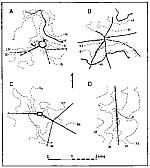 Successful small towns tended to be on or close to Roman roads. We have
seen that in the areas of the south and east with most Roman influence before
the conquest, there was a strong tendency for pre-Roman Iron Age centres to
become small towns. However, these tended to develop and prosper in the long
run only if they were well situated in relation to the network of new roads
which the Roman administration imposed on the province, as was the case with
Braughing (Herts). The recently investigated small town of Elms Farm, Heybridge
(Essex), developed around a pre-Roman Iron Age religious centre. However it
did not develop fully urban characteristics and went into economic decline
after the second century – presumably because it was bypassed by the emergent
road network. Other sites in the vicinity, situated at key positions on the
roads, such as Chelmsford and Braintree (Essex), show much stronger and longer
lasting growth.
Successful small towns tended to be on or close to Roman roads. We have
seen that in the areas of the south and east with most Roman influence before
the conquest, there was a strong tendency for pre-Roman Iron Age centres to
become small towns. However, these tended to develop and prosper in the long
run only if they were well situated in relation to the network of new roads
which the Roman administration imposed on the province, as was the case with
Braughing (Herts). The recently investigated small town of Elms Farm, Heybridge
(Essex), developed around a pre-Roman Iron Age religious centre. However it
did not develop fully urban characteristics and went into economic decline
after the second century – presumably because it was bypassed by the emergent
road network. Other sites in the vicinity, situated at key positions on the
roads, such as Chelmsford and Braintree (Essex), show much stronger and longer
lasting growth.
The growth of some small towns would have been encouraged by the siting of posting stations for the cursus publicus. This may be the case with a small town such as Towcester (Northants). Maintenance of the cursus publicus was at the expense of local communities, but this and a constant stream of officials and other travellers using the road system would have led to a demand for goods and services which could be supplied by a small urban community. As time went on settlements with such origins may have grown and developed into local marketing centres.
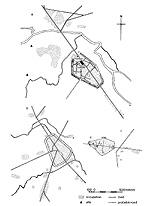 Navigable rivers, always cheaper than roads for the transportation of
goods, were clearly decisive in the foundation and growth of some small towns:
an obvious case is Water Newton, where the River Nene provided a distribution
route for the pottery that was manufactured there on a large scale.
Navigable rivers, always cheaper than roads for the transportation of
goods, were clearly decisive in the foundation and growth of some small towns:
an obvious case is Water Newton, where the River Nene provided a distribution
route for the pottery that was manufactured there on a large scale.
In general the distribution of small towns coincides with that of villas (rural residences of farmers and landowners with Roman architecture and decoration). This suggests that their function was somehow linked to the
exploitation of agricultural estates by the landowning elite, whose agents could have sold surplus agricultural produce in these local market towns. Here also the villa owners could have obtained specialist crafts and services, and the peasant population could have found a local market for produce in order to raise the cash needed to pay taxes. This and the growth of particular manufacturing and craft specialities in small towns are what one might expect of a society where families were no longer self-sufficient and where a money-based economy was developing.
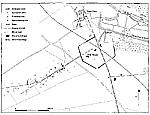
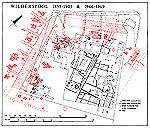 The plan of all but the smallest and most simple small towns suggests
division into zones or areas of distinct function, such as domestic, industrial,
administrative, religious and trading, within a rather haphazard and rudimentary
organised plan. Several small towns exhibit an ‘industrial’ speciality. Brampton (Norfolk) originated at a road junction with river access to the North Sea,
and the settlement grew to cover 50ha. Here an industrial area devoted to pottery
and iron production
lay outside the centre of the town, strung along a road leading to the south-west;
pottery from here was reaching the northern frontier in the period 160-200.
This small town may be exceptional, having a particular connection with the
supply of the military north: significantly it has early defences, not renewed
in the later Roman period, and the town does not seem to have flourished after
the mid-third century. In this respect it may be compared to Wilderspool (Cheshire). Other small towns have evident economic specialities: Charterhouse
(Somerset) was based on lead mining, Middlewich (Cheshire) and Droitwich (Hereford and Worcester) on salt production. These towns presumably superseded
Iron Age production centres.
The plan of all but the smallest and most simple small towns suggests
division into zones or areas of distinct function, such as domestic, industrial,
administrative, religious and trading, within a rather haphazard and rudimentary
organised plan. Several small towns exhibit an ‘industrial’ speciality. Brampton (Norfolk) originated at a road junction with river access to the North Sea,
and the settlement grew to cover 50ha. Here an industrial area devoted to pottery
and iron production
lay outside the centre of the town, strung along a road leading to the south-west;
pottery from here was reaching the northern frontier in the period 160-200.
This small town may be exceptional, having a particular connection with the
supply of the military north: significantly it has early defences, not renewed
in the later Roman period, and the town does not seem to have flourished after
the mid-third century. In this respect it may be compared to Wilderspool (Cheshire). Other small towns have evident economic specialities: Charterhouse
(Somerset) was based on lead mining, Middlewich (Cheshire) and Droitwich (Hereford and Worcester) on salt production. These towns presumably superseded
Iron Age production centres.
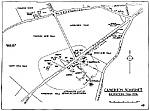 For most small town or village communities agriculture probably remained
the basic function. Several small towns are known to have contained farms or
villa-like farm houses. Winged-corridor houses which if isolated in the countryside
would be termed ‘villas’ appear in some small-town plans, for example at Hibaldstow
(Humbs) and Camerton (Avon). Sometimes the balance between agrarian and other activities altered
over time: Godmanchester (Cambs), predominantly an agrarian village community
in its early
stages (succeeding a military site) developed into a small town where trade,
manufacture and, presumably, official functions were increasingly important.
For most small town or village communities agriculture probably remained
the basic function. Several small towns are known to have contained farms or
villa-like farm houses. Winged-corridor houses which if isolated in the countryside
would be termed ‘villas’ appear in some small-town plans, for example at Hibaldstow
(Humbs) and Camerton (Avon). Sometimes the balance between agrarian and other activities altered
over time: Godmanchester (Cambs), predominantly an agrarian village community
in its early
stages (succeeding a military site) developed into a small town where trade,
manufacture and, presumably, official functions were increasingly important.
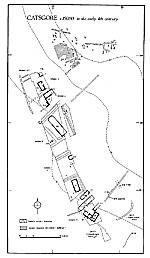 The idea has also been put forward that some small towns may have been
‘estate villages’, dependent on a nearby villa outside the settlement, and
accommodating the labourers who worked on the landowner’s estate. This could
possibly be true of some of the smaller towns (like Camerton (Avon)) and agricultural
villages (like Catsgore (Somerset)) with villas within or close by them, but the clustering of numerous
villas around many small towns suggests that they were not generally dependent
on
a single villa. In fact we have no evidence to tell us whether small towns
were set up and controlled by landowners or by civitas authorities, or whether it varied from case to case.
The idea has also been put forward that some small towns may have been
‘estate villages’, dependent on a nearby villa outside the settlement, and
accommodating the labourers who worked on the landowner’s estate. This could
possibly be true of some of the smaller towns (like Camerton (Avon)) and agricultural
villages (like Catsgore (Somerset)) with villas within or close by them, but the clustering of numerous
villas around many small towns suggests that they were not generally dependent
on
a single villa. In fact we have no evidence to tell us whether small towns
were set up and controlled by landowners or by civitas authorities, or whether it varied from case to case.
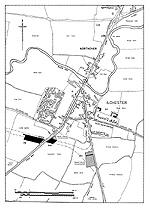 It is often thought that some small towns must have developed administrative
functions. We might expect certain more important small towns to have functioned
as a centre for a pagus, a subdivision of the civitas. Occasionally they may have been promoted to be civitas capitals in their own right, forming the centre for a tribal subdivison. Ilchester (Somerset) on the Fosse Way grew to cover some 20ha, of which a central core
of some 10ha was enclosed within defences by the early-third century. Ilchester
may have
become the administrative centre for a subdivision of the Durotriges, whose
original capital lay at Dorchester. Building inscriptions from Hadrian’s Wall
mention a civitas Durotrigum Lindiniensis, and Lindinis is very probably Ilchester, the only other defended town known
in Durotrigian territory. In the light of this it is notable that several buildings
in the defended central area of Ilchester have produced mosaics, reminiscent
of the decoration high-status town houses that would be more familiar in civitas capitals than in most small towns. There is no way of knowing the date of the
elevation of Ilchester to a (junior) civitas capital: the inscriptions of the civitas…Lindiniensis from Hadrian’s Wall are said to date to the fourth century but could in fact
be as early as the Severan period.
It is often thought that some small towns must have developed administrative
functions. We might expect certain more important small towns to have functioned
as a centre for a pagus, a subdivision of the civitas. Occasionally they may have been promoted to be civitas capitals in their own right, forming the centre for a tribal subdivison. Ilchester (Somerset) on the Fosse Way grew to cover some 20ha, of which a central core
of some 10ha was enclosed within defences by the early-third century. Ilchester
may have
become the administrative centre for a subdivision of the Durotriges, whose
original capital lay at Dorchester. Building inscriptions from Hadrian’s Wall
mention a civitas Durotrigum Lindiniensis, and Lindinis is very probably Ilchester, the only other defended town known
in Durotrigian territory. In the light of this it is notable that several buildings
in the defended central area of Ilchester have produced mosaics, reminiscent
of the decoration high-status town houses that would be more familiar in civitas capitals than in most small towns. There is no way of knowing the date of the
elevation of Ilchester to a (junior) civitas capital: the inscriptions of the civitas…Lindiniensis from Hadrian’s Wall are said to date to the fourth century but could in fact
be as early as the Severan period.
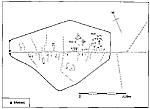 The major defended small town at Kenchester (Hereford
and Worcester), also with buildings of greater than usual pretension, has also
been suggested as a civitas centre, for a subdivision of the Dobunni. A milestone from here has an inscription
that may refer to the respublica civitatis Dobunnorum, but it is not clear whether this tells us anything about the status of Kenchester.
The major defended small town at Kenchester (Hereford
and Worcester), also with buildings of greater than usual pretension, has also
been suggested as a civitas centre, for a subdivision of the Dobunni. A milestone from here has an inscription
that may refer to the respublica civitatis Dobunnorum, but it is not clear whether this tells us anything about the status of Kenchester.
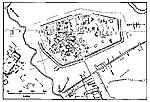 Water Newton (Cambs)
provides a final good example of a large and prosperous small town which also
illustrates the complex problems involved in trying to define the functions
of these settlements. It is the most extensive and coherent small town plan
available from Roman Britain, though it is known mainly from aerial photography
rather than excavation. Here there was no known Iron Age predecessor site,
but a conquest-period Roman fort lay to the north-west, apparently too far
away for the small town to have originated from its vicus. Rather the later civil development is based on Ermine Street, the main Roman
road running north, along which occupation stretched for 3km on either side
of the River Nene. During the second century extensive suburbs accommodated
both manufacturing and agricultural activities (often merging imperceptibly
into the surrounding countryside) and above all pottery-making and iron-working.
The prosperity of Water Newton may have been due in part to the proximity of
the likely imperial estate in the Fens, for which it was conveniently placed,
with its good road and river transport links, to function as a processing centre
and market (and, it has been speculated, an administrative centre).
Water Newton (Cambs)
provides a final good example of a large and prosperous small town which also
illustrates the complex problems involved in trying to define the functions
of these settlements. It is the most extensive and coherent small town plan
available from Roman Britain, though it is known mainly from aerial photography
rather than excavation. Here there was no known Iron Age predecessor site,
but a conquest-period Roman fort lay to the north-west, apparently too far
away for the small town to have originated from its vicus. Rather the later civil development is based on Ermine Street, the main Roman
road running north, along which occupation stretched for 3km on either side
of the River Nene. During the second century extensive suburbs accommodated
both manufacturing and agricultural activities (often merging imperceptibly
into the surrounding countryside) and above all pottery-making and iron-working.
The prosperity of Water Newton may have been due in part to the proximity of
the likely imperial estate in the Fens, for which it was conveniently placed,
with its good road and river transport links, to function as a processing centre
and market (and, it has been speculated, an administrative centre).
The defences (probably late-second or early-third century) enclosed a central nucleus of 18ha, which displays a typical development of side streets and back areas from an original build up along the frontages of the main road. Two courtyard buildings in the central part of the defended area (unexcavated) have been suggested as a mansio and some kind of market or administrative, forum-like structure, the latter (if correctly understood) quite unusual for a ‘small town’. Here again there is a possibility that the town was raised in status to become a civitas centre. A milestone of 276 from the site is known that measures one mile, presumably from the town itself: normally milestones only measure distance from civitas capitals or cities. The possibility of a public building would support this idea, but it is unclear exactly when such a promotion might have taken place. An (undated) mortarium stamp clearly gives Durobrivae the status of a vicus. This might predate a promotion of the town to a civitas capital; on the other hand there is reason to believe that the capital city of a civitas, as opposed to the whole political entity, might be designated a vicus.
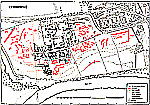 Two urban centres immediately south of Hadrian’s Wall, Carlisle (Cumbria)
and Corbridge (Northumb), form an exception to the rule that the distribution of small towns
matches that of villas. Both sites started life as first-century forts, and
both continued
to have a military site at their centre. Despite their continued military involvement,
the civilian element of these settlements had become important and economically
prosperous by the later-second century: enough for Carlisle to be promoted
to the status of civitas Carvetiorum shortly afterwards (probably under Septimius Severus). Unfortunately, although
it is known to have been of considerable size, very little is known in detail
of the plan of the town at Carlisle or the types of buildings that it contained,
and it is not even known for certain whether it was walled. Corbridge may also
have been given independent urban status by the early third century, by which
time it covered over 25ha. The plan is dominated by strip buildings, packed
along the street frontages in a way more reminiscent of the military vici than the southern small towns. A very rudimentary street grid surrounded the
military compound at the core. There was a possible mansio. Although such essentially unplanned and haphazard looking growth is reminiscent
of the small towns of the lowland part of the province, the prosperity of both
Corbridge and Carlisle was probably based entirely on the nearby presence of
the garrison of Hadrian’s Wall, for which they provided supplies and services.
If they ever became real marketing or administrative centres for the natives
of the surrounding countryside, this was after AD 200. Villas, and other signs
of exploitation of the land by a Romanised elite are, to date, absent from
their hinterlands.
Two urban centres immediately south of Hadrian’s Wall, Carlisle (Cumbria)
and Corbridge (Northumb), form an exception to the rule that the distribution of small towns
matches that of villas. Both sites started life as first-century forts, and
both continued
to have a military site at their centre. Despite their continued military involvement,
the civilian element of these settlements had become important and economically
prosperous by the later-second century: enough for Carlisle to be promoted
to the status of civitas Carvetiorum shortly afterwards (probably under Septimius Severus). Unfortunately, although
it is known to have been of considerable size, very little is known in detail
of the plan of the town at Carlisle or the types of buildings that it contained,
and it is not even known for certain whether it was walled. Corbridge may also
have been given independent urban status by the early third century, by which
time it covered over 25ha. The plan is dominated by strip buildings, packed
along the street frontages in a way more reminiscent of the military vici than the southern small towns. A very rudimentary street grid surrounded the
military compound at the core. There was a possible mansio. Although such essentially unplanned and haphazard looking growth is reminiscent
of the small towns of the lowland part of the province, the prosperity of both
Corbridge and Carlisle was probably based entirely on the nearby presence of
the garrison of Hadrian’s Wall, for which they provided supplies and services.
If they ever became real marketing or administrative centres for the natives
of the surrounding countryside, this was after AD 200. Villas, and other signs
of exploitation of the land by a Romanised elite are, to date, absent from
their hinterlands.
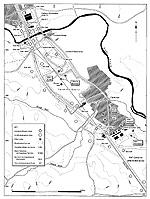
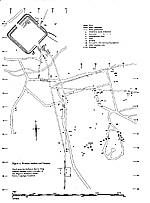 A final northern outlier is Catterick (N Yorks), an important military base and staging post between York and Corbridge.
Here civilian occupation grew to stretch for some three miles along Dere Street,
with a walled nucleus at the crossing of the river Swale. It now seems clear
that this walled settlement was always attached to a fort. There is a scattering
of villas known in the area around Catterick. But the military connections
of the place are clear, and as a ‘small-town’ it stands (with Corbridge and
Carlisle) isolated from the main distribution further south. As a possible
hybrid between a military vicus and a marketing centre for the surrounding civilian population it may be compared
to the settlement at Malton (N Yorks), only 60km south-east, also walled and attached to a Roman fort, with
villas in the nearby countryside. The sites at Piercebridge (Durham) and Newton Kyme (N Yorks) also need to be considered in this light.
A final northern outlier is Catterick (N Yorks), an important military base and staging post between York and Corbridge.
Here civilian occupation grew to stretch for some three miles along Dere Street,
with a walled nucleus at the crossing of the river Swale. It now seems clear
that this walled settlement was always attached to a fort. There is a scattering
of villas known in the area around Catterick. But the military connections
of the place are clear, and as a ‘small-town’ it stands (with Corbridge and
Carlisle) isolated from the main distribution further south. As a possible
hybrid between a military vicus and a marketing centre for the surrounding civilian population it may be compared
to the settlement at Malton (N Yorks), only 60km south-east, also walled and attached to a Roman fort, with
villas in the nearby countryside. The sites at Piercebridge (Durham) and Newton Kyme (N Yorks) also need to be considered in this light.
What characterises the small-towns is an absence of public buildings (such as a forum, theatre or large public baths) and the lack of an organised plan or street grid into which the buildings are fitted.

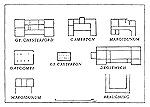 The ‘strip-house’, or long rectangular building fronting onto a street (familiar from the larger
towns and the military vici) is usually said to be the ubiquitous building type. Clearly, simple rectangular
buildings predominate, but many seem to have had an agricultural purpose rather
than being for craft, industry or trading as in the military vici, where the ‘strip-houses’ may have been inspired by Italian prototypes. In the
small towns the simple rectangular buildings do not always have the same elongated
form characteristic of the miltary vici. There are cases, as at Godmanchester, where they lie parallel, rather than
presenting their narrow frontage, to the roads, and are surrounded by agricultural
plots. On the other hand, there are towns where elongated buildings fronting
onto roads clearly had a commercial importance: Water Newton, and the ‘miltary’
small towns of Catterick and Corbridge in the North. But it may be that in
small towns as a whole rectangular buildings, while obviously a divergence
from the pre-Roman Iron Age round house building tradition, owed their form
to local, and agricultural, precedents. Round houses in the native tradition
are also represented in small-towns. We also find aisled buildings of various
types, which are used variously for agricultural or craft purposes.
The ‘strip-house’, or long rectangular building fronting onto a street (familiar from the larger
towns and the military vici) is usually said to be the ubiquitous building type. Clearly, simple rectangular
buildings predominate, but many seem to have had an agricultural purpose rather
than being for craft, industry or trading as in the military vici, where the ‘strip-houses’ may have been inspired by Italian prototypes. In the
small towns the simple rectangular buildings do not always have the same elongated
form characteristic of the miltary vici. There are cases, as at Godmanchester, where they lie parallel, rather than
presenting their narrow frontage, to the roads, and are surrounded by agricultural
plots. On the other hand, there are towns where elongated buildings fronting
onto roads clearly had a commercial importance: Water Newton, and the ‘miltary’
small towns of Catterick and Corbridge in the North. But it may be that in
small towns as a whole rectangular buildings, while obviously a divergence
from the pre-Roman Iron Age round house building tradition, owed their form
to local, and agricultural, precedents. Round houses in the native tradition
are also represented in small-towns. We also find aisled buildings of various
types, which are used variously for agricultural or craft purposes.
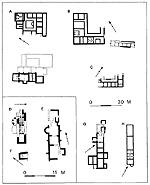 We have already noticed the occurrence of high status houses like wing-corridor
villas in small towns. High-status housing on the courtyard principle, familiar from the larger towns, is only occasionally known (e.g. at Kenchester,
and Water Newton, and even in these cases the plans of the buildings are incompletely
known). Temples are well attested and are discussed later.
We have already noticed the occurrence of high status houses like wing-corridor
villas in small towns. High-status housing on the courtyard principle, familiar from the larger towns, is only occasionally known (e.g. at Kenchester,
and Water Newton, and even in these cases the plans of the buildings are incompletely
known). Temples are well attested and are discussed later.
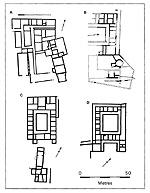
 Certain
courtyard buildings in small towns have been identified as mansiones, or
posting stations on the cursus publicus. Although there is no proof in any of these cases, this seems very reasonable.
At Water Newton a courtyard building occurs right next to Ermine Street, the
main road through the town, and a building similarly identified as a mansio at Wall sits very close to Watling Street. At Godmanchester the mansio lies back some 60m from the Ermine Street frontage, behind whatever buildings
fronted the road. Independent bath houses of varying size are also known at
a number of small towns (e.g. Brampton, Braughing, Margidunum (Notts), Cowbridge), but it is not clear for whose benefit they were built.
Certain
courtyard buildings in small towns have been identified as mansiones, or
posting stations on the cursus publicus. Although there is no proof in any of these cases, this seems very reasonable.
At Water Newton a courtyard building occurs right next to Ermine Street, the
main road through the town, and a building similarly identified as a mansio at Wall sits very close to Watling Street. At Godmanchester the mansio lies back some 60m from the Ermine Street frontage, behind whatever buildings
fronted the road. Independent bath houses of varying size are also known at
a number of small towns (e.g. Brampton, Braughing, Margidunum (Notts), Cowbridge), but it is not clear for whose benefit they were built.
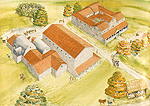

Sometime after the 160s numerous small towns in Britain acquired defensive circuits, in common with the major towns. Unfortunately the dating evidence is rarely precise, usually indicating only a ‘later-second or early-third century’ date, and it is therefore impossible to say whether all of these circuits were provided around the same time. Initially these were earth banks with external ditches. These circuits were usually reconstructed in stone in the course of the third and fourth centuries. The important point about these defences is that in the case of the small towns they did not enclose the total area of occupation, almost always leaving out extensive suburbs which continued in use; the defences would thus seem to have protected what was perceived as an urban core, with special importance or function. There is a class of smaller towns and roadside settlements with later (typically third century) defensive circuits imposed upon them (as small as 4-6ha), creating a small defended strong points along roads. But most of the larger and more obviously ‘urban’ looking of the ‘small towns’ and many of the smaller settlements besides, received defences as early as the second century. The enclosed areas vary greatly in size, from Water Newton at 18ha to Penkridge/Water Eaton (Staffs) at 3ha.
The lack of detailed, large-scale excavation in small towns makes it difficult to establish clear patterns of development. The earliest buildings at these sites were almost always timber in construction, and in many areas timber building always predominated. This depended very much on whether building stone was easily available locally. The widespread use of timber in these settlements explains why they are less well-known and understood than villas and major towns: small towns without many stone buildings are obviously very difficult to recognise and study archaeologically. It is also very difficult to study the pre-Roman or very early-Roman phases of these towns, which being timber, might be largely obscured by later Roman reconstruction, sometimes in stone, on the same site.
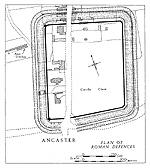
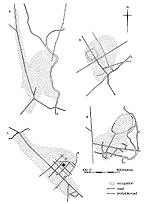 Many developments that can be perceived, such as the emergence of high-status
houses or Kenchester, and the provision of a large central building at Water
Newton that may have had an administrative purpose, possibly belong to the
third or fourth century, which was, on the whole, the period of greatest and
development and growth in small towns. Nevertheless small towns had attained
an economic importance and were to be found throughout the developed part of
the province by AD 200. This is apparent from the widespread provision of defences
before the end of the second century and from the fact that certain settlements
(such as Elms Farm Heybridge) reached their peak of development by c. 200 and
went into decline thereafter. In general the second century saw growing numbers
of strip buildings, often strung out along road frontages, and increasingly
for trade and industry as well as agricultural purposes. Growth of this kind
can be seen at Godmanchester, Ashton (Notts), Ancaster (Lincs), Great Chesterford (Essex), and Wanborough (Wilts). This suggests that during the second century
economic development generated the need for convenient local markets and a
wider range of craftsmen. Before
the end of the second century some small towns developed a more complex, though
still very irregular, street layout at their centre, in clear contrast to roadside settlements where expansion took the form of
a straggling ribbon development. At Water Newton a rudimentary grid of side
streets may once have extended beyond the line of the second-century defences.
At Alcester (Warks) an industrial quarter south of the probable centre of the settlement
was already well established by the mid-second century, implying that the main
street network
in the centre of the settlement had developed before this date. But even at
urban looking sites like Kenchester and Water Newton, where networks of side
streets developed, the plans remained dominated by the original strung out
ribbon development at their centre, and it looks as if the expansion from this
has been carried out in a haphazard and piecemeal way.
Many developments that can be perceived, such as the emergence of high-status
houses or Kenchester, and the provision of a large central building at Water
Newton that may have had an administrative purpose, possibly belong to the
third or fourth century, which was, on the whole, the period of greatest and
development and growth in small towns. Nevertheless small towns had attained
an economic importance and were to be found throughout the developed part of
the province by AD 200. This is apparent from the widespread provision of defences
before the end of the second century and from the fact that certain settlements
(such as Elms Farm Heybridge) reached their peak of development by c. 200 and
went into decline thereafter. In general the second century saw growing numbers
of strip buildings, often strung out along road frontages, and increasingly
for trade and industry as well as agricultural purposes. Growth of this kind
can be seen at Godmanchester, Ashton (Notts), Ancaster (Lincs), Great Chesterford (Essex), and Wanborough (Wilts). This suggests that during the second century
economic development generated the need for convenient local markets and a
wider range of craftsmen. Before
the end of the second century some small towns developed a more complex, though
still very irregular, street layout at their centre, in clear contrast to roadside settlements where expansion took the form of
a straggling ribbon development. At Water Newton a rudimentary grid of side
streets may once have extended beyond the line of the second-century defences.
At Alcester (Warks) an industrial quarter south of the probable centre of the settlement
was already well established by the mid-second century, implying that the main
street network
in the centre of the settlement had developed before this date. But even at
urban looking sites like Kenchester and Water Newton, where networks of side
streets developed, the plans remained dominated by the original strung out
ribbon development at their centre, and it looks as if the expansion from this
has been carried out in a haphazard and piecemeal way.
 Certain small towns developed at religious foci of the pre-Roman Iron
Age. The most celebrated example of this is Bath (Avon), where hot springs were the origin of the cult of Sulis, identified
with the Roman deity Minerva. A great sanctuary and classical temple dedicated
to Sulis
Minerva had fully developed by the end of the first century, and inscriptions
show that it attracted visitors, military and civilian, from afar. As a small
town, however, Bath is almost wholly exceptional in employing classical architecture
in religious building.
Certain small towns developed at religious foci of the pre-Roman Iron
Age. The most celebrated example of this is Bath (Avon), where hot springs were the origin of the cult of Sulis, identified
with the Roman deity Minerva. A great sanctuary and classical temple dedicated
to Sulis
Minerva had fully developed by the end of the first century, and inscriptions
show that it attracted visitors, military and civilian, from afar. As a small
town, however, Bath is almost wholly exceptional in employing classical architecture
in religious building.
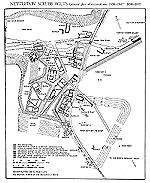
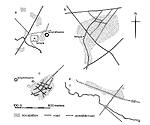 In
other cases temples are usually of Roman-Celtic form, usually square but sometimes
circular or polygonal in shape. Temples of this type are seen
in the remarkable precinct or temenos containing temples at Springhead. This sanctuary, associated with the local
springs that give the place its modern name, probably had pre-Roman Iron Age
origins. Further examples where a temple, probably deriving from an Iron Age
shrine, occupies a prominent space respected by the street system of a small
town, are provided by Wycomb (Glos) and the recently recorded site at Elms
Farm Heybridge. In other cases temples were placed outside the main settlement
areas of small towns: for example Harlow (Essex), where a temple and its precinct
sat in a 4.2ha ditched enclosure separate from the main settlement. The existence
and prosperity of a number of other small towns, besides Bath and Springhead,
seem to have been primarily based on the importance and popularity of a religious
sanctuary. For example, Nettleton , only 10 miles north-east of Bath, which contains a great octagonal temple
to Apollo Cunomaglos; and Frilford (Oxon), where a small town of some 30ha surrounded a religious complex including
a temple, temenos enclosure, and even an amphitheatre, and where continuity from the pre-Roman
Iron Age can be demonstrated.
In
other cases temples are usually of Roman-Celtic form, usually square but sometimes
circular or polygonal in shape. Temples of this type are seen
in the remarkable precinct or temenos containing temples at Springhead. This sanctuary, associated with the local
springs that give the place its modern name, probably had pre-Roman Iron Age
origins. Further examples where a temple, probably deriving from an Iron Age
shrine, occupies a prominent space respected by the street system of a small
town, are provided by Wycomb (Glos) and the recently recorded site at Elms
Farm Heybridge. In other cases temples were placed outside the main settlement
areas of small towns: for example Harlow (Essex), where a temple and its precinct
sat in a 4.2ha ditched enclosure separate from the main settlement. The existence
and prosperity of a number of other small towns, besides Bath and Springhead,
seem to have been primarily based on the importance and popularity of a religious
sanctuary. For example, Nettleton , only 10 miles north-east of Bath, which contains a great octagonal temple
to Apollo Cunomaglos; and Frilford (Oxon), where a small town of some 30ha surrounded a religious complex including
a temple, temenos enclosure, and even an amphitheatre, and where continuity from the pre-Roman
Iron Age can be demonstrated.
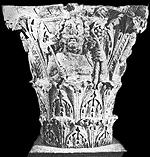 Sites of the Frilford type clearly provide a parallel to the great sanctuaries
of Gaul which often developed in seemingly remote places, typically containing
temple, theatre, baths (e.g. Ribemont-sur-Ancre near Amiens). In lowland Britain
religious centres of this kind evidently had the same importance, and no doubt
attracted a marketing function which grew naturally out of their character
as a place where many people came from a great distance to gather together
for religious reasons. This in turn will have fuelled their development into
towns of economic importance. It is notable that Bath, for example, developed
its own industries, including pewter vessel manufacture. The existence of these
great sanctuary sites should not allow us to overlook the fact that there is
evidence for the existence of humbler individual shrines throughout settlements
of the small-town type, descending even to those of the smallest and most agricultural
character. This is not surprising: we have seen that villa-type buildings, and agricultural dwellings and aisled buildings occur in
small towns, so it is hardly surprising that another feature of the countryside,
the isolated Romano-Celtic temple or shrine, should also be represented in
these settlements. As an example, we may take Irchester, which contains a temple
within a temenos (associated with the remains of a Jupiter column). The prominence of a Romano-Celtic temple here is significant as it occurs
in the context of an organic looking street development which probably betrays
a pre-Roman origin; the same is true of Elms Farm Heybridge. But probable shrines
can also occur in the most simple roadside settlements that have grown up alongside
Roman roads, such as Bourton-on-the-Water (Glos), where a semi-circular building
by the Fosse Way has been interpreted as a shrine.
Sites of the Frilford type clearly provide a parallel to the great sanctuaries
of Gaul which often developed in seemingly remote places, typically containing
temple, theatre, baths (e.g. Ribemont-sur-Ancre near Amiens). In lowland Britain
religious centres of this kind evidently had the same importance, and no doubt
attracted a marketing function which grew naturally out of their character
as a place where many people came from a great distance to gather together
for religious reasons. This in turn will have fuelled their development into
towns of economic importance. It is notable that Bath, for example, developed
its own industries, including pewter vessel manufacture. The existence of these
great sanctuary sites should not allow us to overlook the fact that there is
evidence for the existence of humbler individual shrines throughout settlements
of the small-town type, descending even to those of the smallest and most agricultural
character. This is not surprising: we have seen that villa-type buildings, and agricultural dwellings and aisled buildings occur in
small towns, so it is hardly surprising that another feature of the countryside,
the isolated Romano-Celtic temple or shrine, should also be represented in
these settlements. As an example, we may take Irchester, which contains a temple
within a temenos (associated with the remains of a Jupiter column). The prominence of a Romano-Celtic temple here is significant as it occurs
in the context of an organic looking street development which probably betrays
a pre-Roman origin; the same is true of Elms Farm Heybridge. But probable shrines
can also occur in the most simple roadside settlements that have grown up alongside
Roman roads, such as Bourton-on-the-Water (Glos), where a semi-circular building
by the Fosse Way has been interpreted as a shrine.
 Excavation at Wavendon Gate (Bucks) and the newly discovered site at Hardwick Park, Sedgefield (Durham)
has revealed in each case a very large pit, in the former case 7m in diameter
and 3m deep.
It is difficult to suggest a practical purpose for these pits, and they may
indicate the perpetuation of native ritual practices in small towns. If so
they underline the essentially indigenous nature of their inhabitants.
Excavation at Wavendon Gate (Bucks) and the newly discovered site at Hardwick Park, Sedgefield (Durham)
has revealed in each case a very large pit, in the former case 7m in diameter
and 3m deep.
It is difficult to suggest a practical purpose for these pits, and they may
indicate the perpetuation of native ritual practices in small towns. If so
they underline the essentially indigenous nature of their inhabitants.
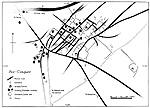 Extensive cemeteries are known outside, or on the fringes of, some small
towns. However, there has been insufficient systematic excavation to show the
extent to which large organised cemeteries (suggesting an advanced sense of
urban community) had become common before the end of the second century. It
is probable that early cemeteries await discovery: a cemetery containing first
century inhumations has, for example, been excavated at Baldock (Herts).
Extensive cemeteries are known outside, or on the fringes of, some small
towns. However, there has been insufficient systematic excavation to show the
extent to which large organised cemeteries (suggesting an advanced sense of
urban community) had become common before the end of the second century. It
is probable that early cemeteries await discovery: a cemetery containing first
century inhumations has, for example, been excavated at Baldock (Herts).
The vici or small towns of Roman Britain were long a neglected and poorly understood aspect of the archaeology of the province. As we find out more about them, it is becoming clear that their character was part urban, part rural. They contained members of the basic rural population, often carrying out agricultural activities as their ancestors must have done, but also buying, selling, trading and manufacturing where the communications network imposed by the Romans offered the best opportunities. The small towns were certainly a widespread and prominent feature of the British provincial landscape as early as the second century, although mainly restricted to the ‘villa-landscapes’ of the lowland, south-eastern part of the of the Island. By AD 200 at least some of these places became administrative centres, which the local inhabitants would have identified as ‘their’ town, though how political authority and tax-collection was divided between the small towns and the civitas capitals is not understood. Yet the fact that the small towns grew in an haphazard and unplanned, but essentially prosperous fashion, and continued to do so in the later-Roman period, emphasises that their inhabitants were from the indigenous rural population, responding to the development of the provincial economy. The ‘small towns’ – ranging from large agricultural villages to near-cities – offer the best prospect of finding out how the development of the Roman province affected the bulk of the rural population in Britain during the century and a half following the conquest.
Information on most of the ‘small towns’ of Roman Britain known or researched up to 1990 can be found in:
Burnham, B.C. and Wacher, J., The Small Towns of Roman Britain (London, 1990)
For important earlier accounts and alternative discussions of the role of ‘small towns, see also:
Burnham, B C, ‘The origins of Romano-British ‘Small Towns’, Oxford J. of Archaeol. 5 (1986), 185-203
Burnham, B.C., ‘The morphology of Romano-British small towns’, Archaeol. Journal 144 (1987), 156-90
Esmonde-Cleary, S., Extra-mural areas of Romano-British Towns (Brit,. Archaeol. Reports 169) (Oxford, 1987)
Esmonde-Cleary, S., ‘Small towns past and future’, Britannia 23 (1992), 341-4
Hanley, R., Villages in Roman Britain (Shire Books, Princes Risborough, 2000).
Hingley, R., Rural Settlement in Roman Britain (London, 1989)
Millett, M., The Romanization of Britain (Cambridge, 1990)
Rodwell, W. and Rowley, T. (eds.), The Small Towns of Roman Britain (Brit. Archaeol. Reports 15, 1975)
Smith, R.F., Roadside settlements in Lowland Roman Britain (Brit. Archaeol. Reports 157) (Oxford, 1987)
Todd, M.,’The Small Towns of Roman Britain’, Britannia 1 (1970), 114-30
B. Jones and D. Mattingly, An Atlas of Roman Britain (Blackwell: Oxford, 1990)
Much new discovery and thinking has taken place since the appearance of the volume by Burnham and Wacher in 1990. For this see particularly the essays in:
Brown, A.E. (ed.), Roman Small Towns in Eastern England and beyond (Oxford, 1995)
Of particular interest in this volume are:
A.E. Brown, ‘Roman small towns and medieval small towns’ (1-6)
B. Burnham, ‘Small towns: the British perspective’ (7-17)
M. Eddy, ‘Kelvedon and the fort myth in the development of Roman small towns in Essex’ (119-128)
Also, the volume contains a number of regional surveys:
D. Gurney, ‘Small towns and villages of Roman Norfolk’ (53-67)
J. Plouvier, ‘A hole in the distribution map: the characteristics of small towns in Suffolk’ (69-80)
P. Liddle, ‘Roman small towns in Leicestershire’ (80-94)
B. Whitwell, ‘Some Roman small towns in North Lincolnshire and South Humberside’ (95-102).
Some recent publications of small towns:
Rodwell, K.A., The Prehistoric and Roman settlement at Kelvedon, Essex (CBA Research Report 63, London, 1988)
Drury, P.J.,The Mansio and other Sites in the South-Eastern sector of Caesaromagus (Chelmsford) (CBA Research Report 66, London, 1988)
Wickenden, N.P., Excavations at Great Dunmow, Essex: a Romano-British small town in the Trinovantian Civitas (Chelmsford 1988)
Wickenden, N.P., The Temple and other sites in the north-eastern sector of Caesaromagus (Chelmsford) (CBA Research Report 75, London, 1992)
Taylor, J. ,‘Surveying small towns: the Romano-British roadside settlement at Shiptonthorpe, East Yorkshire’, in Brown, A.E. (ed.), Roman Small Towns in Eastern England and beyond (Oxford, 1995), 39-52
Simmons, B., ‘Sapperton’, in Brown, A.E. (ed.), Roman Small Towns in Eastern England and beyond (Oxford, 1995), 157-165
Dawson, M., ‘Sandy’, in Brown, A.E. (ed.), Roman Small Towns in Eastern England and beyond (Oxford, 1995), 167-176
May, J., Dragonby: report on excavations at an Iron Age and Romano-British Settlement in North Lincolnshire (Oxbow Mono. 61, Oxford, 1996)
Williams, R.J., Hart, P.J. and Williams, A.T.L., Wavendon Gate: a Late Iron Age and Roman Settlement in Milton Keynes (Buckinghamshire Arch. Soc. Mono. 10, Bristol, 1996)
Timby, J.R., Excavations at Kingscote and Wycomb, Gloucestershire: a Roman Estate Cente and Small Town in the Cotswolds with notes on related settlements (Cotswold Archaeological Trust, Cirencester, 1998)
Alexander, J. and Pullinger, J., Roman Cambridge: Excavations on Castle Hill 1956-88 (Proc. Cambridge Antiquarian Soc. 88, ed. A. Taylor, Cambridge 2000
New Discoveries
Atkinson, M. and Preston, S.J., ‘The Late Iron Age and Roman settlement at Elms Farm, Heybridge, Essex, excavations 1993-5: an interim report’, Britannia 29 (1998), 85-110
Boutwood, Y., ‘Roman road and settlement, Long Bennington, Lincolnshire’, Britannia 29 (1998), 307-9
Leach, P. et al., Fosse Lane, Shepton Mallet: Excavation of a Romano-British Roadside settlement in Somerset (London, 2000)
Carne, P. and Mason, D., ‘The Sedgefield Archaeology Project’, Archaeology County Durham (County Durham Books, 2006), 24-27
Winton, H., ‘A possible Roman small town at Sansom’s Platt, Tackley, Oxon.’, Britannia 32 (2001), 304-309
Sauer, E., ‘The Military Origins of the Roman Town of Alchester, Oxfordshire’, Britannia 30 (1999), 289-297
Sauer, E., ‘Inscriptions from Alchester: Vespasian’s base of the Second Augustan Legion(?)’, Britannia 36 (2005), 101-133
The ‘Military vici
Salway, P., The Frontier People of Roman Britain (Cambridge University Press, 1965)
Sommer, C.S., The Military Vici in Roman Britain: aspects of their origins, their location and layout, administration, function and end (Brit. Archaeol. Reports 129, Oxford, 1984)